In this example, three assignments have been added to the Moodle course. Two have a maximum grade of 100 and one has a maximum grade of 50. If you want to follow the instructions to set up an example Gradebook, create three assignments and choose 100 as the maximum grade for Task 1 and Task 2 and 50 for Task 3. Grade Task 1 and Task 2 for at least one learner. In the following example, you can see activities we use:
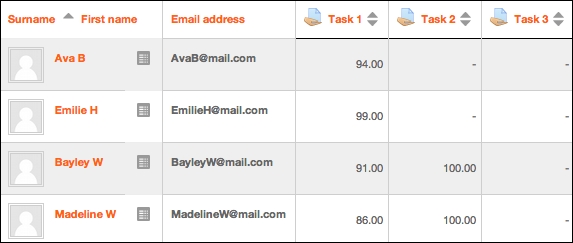
The aggregation type of this course will be the mean of grades, which will present a final average grade.
Let's go into the Grades area and choose the aggregation type:
- Click on the Administration block and then click on Grades.
You should see a table like the previous one, which will show you the grades of each assignment for each student. If you see an overall average row at the bottom of the screen, don't let it confuse you. This is an average grade based on all the students in the course rather than an individual student's average grade, and it is shown for all aggregation types. You will learn more about customizing this screen in Chapter 7, Reporting with the Gradebook.
- From the drop-down list at the top of the screen, find Categories and items and choose Simple view (or click on the Categories and items tab if your screen shows the tabs view).
This is where we can start to customize the Gradebook and choose the aggregation type.

You can see that the categories and items screen is another table with column headings that explain the content of the table. You can change the aggregation of the course from the drop-down list in the aggregation column. Click on the drop-down list box and choose Mean of grades, then click on Save changes at the bottom of the screen. This is not the only way to change the aggregation type, and we will look at other ways of doing this later in the chapter.
Take a look at the Max grade column. This shows you the maximum grade possible for each graded item in the course and the course total, which is the number at the bottom of the table, shows you the total final grade possible. In this example, the course total is displayed as 100 as this is the default (except for the sum of grades aggregation type), but it can be easily changed by typing an alternative number into this course total box.
Let's switch back to view the Gradebook. In the drop-down list at the top of the screen, find View icon and click on Grader report (or click on View on the tab at the top of the Gradebook screen).
Note
Before we look at other customizations possible, let's take a quick look at how the aggregation will work in this example. Remember, for this example, we are using the mean of grades aggregation type, and this type of calculation converts the grades to a normalized score, adds them all together, and divides this normalized total by the total number of graded items in the course. Finally, this is multiplied by the course total—in this case, 100—to provide the final score.
Take a look at the following screenshot and you can see the Course total that shows you the mean grade for each student:
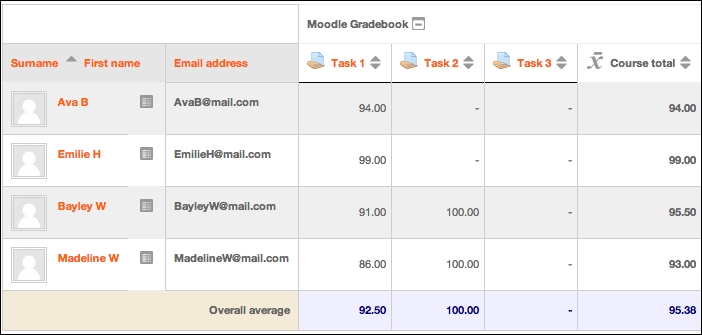
Take a look at the information of Bayley W, who has completed two assessments that have been graded. His current course total is 95.50, which could be this calculation: 91.00 + 100.00 / 2 (that is, the two assignment grades added together and divided by the total number of grades added together). However, this only works because the course total is the same as the assignment maximum grades. If the course total was 50, we could not have performed this simple calculation for the course total. This is why Moodle first normalizes grades and then multiplies this by the maximum course total possible. So, the calculation that Moodle is actually doing for Bayley W is shown in the following table:
|
Task 1 |
Task 2 |
Total |
Mean aggregation |
Final grade shown in the Gradebook | |
|---|---|---|---|---|---|
|
Maximum grade possible |
100 |
100 | |||
|
Grade awarded |
91.00 |
100.00 |
191 |
95.50 | |
|
Normalized grade |
0.91 (91/100) |
1 (100/100) |
1.91 (0.91+1) |
0.955 (1.91/2) |
95.50 (.0955*100) |
As you can see, only the assessments that have actually been graded are included in the aggregation for the course total. So, the student is given a current grade based on work that has already been completed. However, what if you want to provide a running total? What if you want the students to know the final grade they will get based on the work completed to date even if it is not complete yet? This is particularly important if all assignments need to be completed in order to complete the course and gain a final grade.
We can tell the Gradebook to include all the graded activities in the aggregation. Moodle will add up each assessed activity, which will include a zero score for each assessed item that has not been submitted or graded yet, and then it will divide the grade by the total number of assessed grades in the course regardless of whether they have been graded or not. In this example, it will be divided by three. Let's go and apply this and see it in action:
- Go to Categories and items again (either by clicking on the drop-down list and clicking on Simple view under the categories and items heading or by clicking on Categories and items in the tabs bar).
- In the top row in the Actions column (in the same row as the aggregation drop-down list), the first icon is an edit icon (a cog icon for the default Moodle theme; if you hold your mouse over the first icon, it will give you a screen tip that says edit). Click on the edit icon.
We are only going to use the Grade category section for now. However, the options that we need are not shown on the screen so we need to click on Show more:
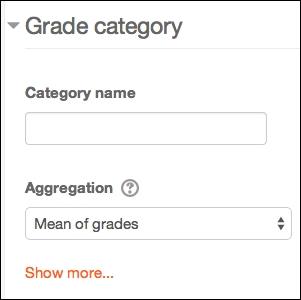
Note that you can change the aggregation method on this screen. However, the setting we need to change is the Aggregate only non-empty grades option. Notice that this box is currently checked. Click on the box to remove the tick and scroll to the bottom of the screen to go to Save changes.
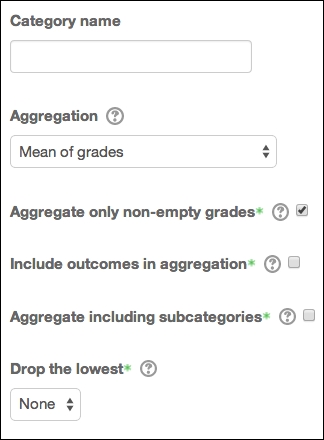
Let's take a look at the Gradebook again to see what difference this has made. (To go back to the Gradebook, use the drop-down list at the top of the screen, find View, and click on Grader report or click on View in the tab at the top of the Gradebook screen.)
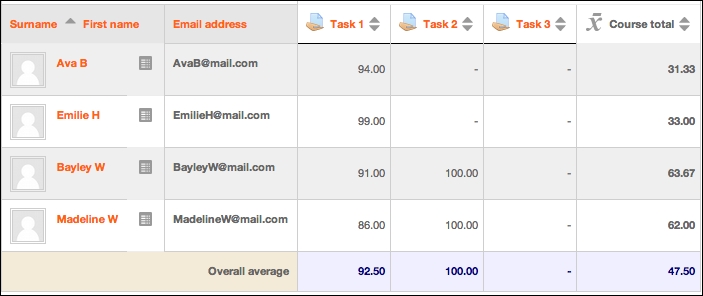
You can see that the course total has now changed as it is including all the graded items in the aggregation. The fewer items that have been marked the lower the grade will be. The calculation that is taking place for Bayley W is now as follows:
|
Task 1 |
Task 2 |
Task 3 |
Total |
Mean aggregation |
Final grade shown in Gradebook | |
|---|---|---|---|---|---|---|
|
Max grade possible |
100 |
100 |
50 | |||
|
Grade awarded |
91.00 |
100.00 |
0 |
191 |
63.67 | |
|
normalized grade |
0.91 (91/100) |
1 (100/100) |
0 (0/50) |
1.91 (0.91+1+0) |
0.6367 (1.91/3) |
63.67 (.06367*100) |
We have been using the mean of grades, but there are two other mean aggregation types.
Let's keep using this example but change the Gradebook to show Simple weighted mean of grades and the Weighted mean of grades to see how they affect the final aggregation. This will also give us the chance to practice how to change aggregation types within the course.
In the mean of the grades aggregation type that we have been using, the totals for each assignment type are not taken into consideration in the final aggregation (other than for the normalization process). It is only the grades that are used. However, in the simple weighted mean of the grades aggregation type, the maximum grade of each assignment is very important. This aggregation type uses the assignment totals in the mean aggregation step of the calculation.
Let's change the aggregation of the course and see what it does to the final grade:
- Go to Categories and items again (either by clicking on the drop-down list and clicking on Simple view under the categories and items heading, or by clicking on Categories and items in the tabs bar).
- Change the aggregation type to Simple weighted mean of grades with the drop-down list in the Aggregation column, and click on Save changes at the bottom of the screen.
- Now, switch back to view the Gradebook. On the drop-down list at the top of the screen, find View and click on Grader report (or click on View on the tab at the top of the Gradebook screen).
Note how the course total score has changed. Look at Bayley W again. His previous score in the mean of grades aggregation was 63.67 (remember that the Gradebook is currently using all the assessed activities in the calculations and not just those that have been marked and graded). His score is 76.40 now.
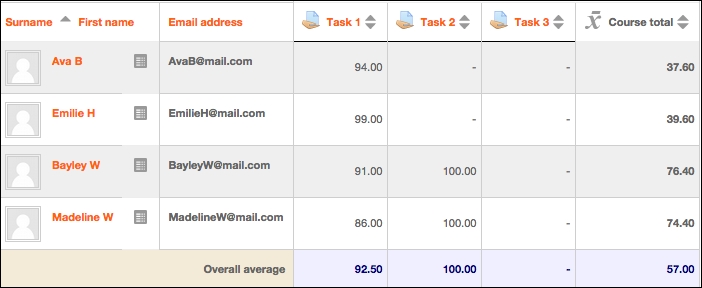
The calculation used in the simple weighted mean of grades is shown in the following table:
|
Task 1 |
Task 2 |
Task 3 |
Total |
Mean aggregation |
Final grade shown in the Gradebook | |
|---|---|---|---|---|---|---|
|
Maximum grade possible |
100 |
100 |
50 |
250 | ||
|
Grade awarded |
91.00 |
100.00 |
0 |
191 |
63.67 | |
|
Normalized grade |
0.91 (91/100) |
1 (100/100) |
0 (0/50) |
1.91 (.91+1+0) | ||
|
Plus weighting |
91 (.91*100) |
100 (1*100) |
0 (0*50) |
191 (91+100+0) |
.764 (191/250) |
76.40 (.764*100) |
As done previously, the grade awarded is normalized. However, in this aggregation method, this normalized grade is multiplied by the maximum grade possible for the assessed activity. (In theory, the normalization process is not required in this aggregation type, as the normalization and weighting calculations cancel each other back to the original grade awarded. However, in practice, Moodle always normalizes this aggregation type.) However, the calculation of the mean aggregation is different in this method.
Instead of dividing the normalized total by the number of grades in the course (in our example, this meant dividing the total by three), the simple weighted mean aggregation divides the normalized total by the total maximum grade possible (which is each of the maximum grades for each activity added together). In this case, it divides the normalized and weighted total by 250.
There is one final method of calculating a mean grade and this requires some additional options to be set by the teacher. Let's have a go at using the 'weighted mean of grades' aggregation method.
In this method, each graded item in the course is manually given a weighting. In the mean of grades method, there is no weighting involved as it is a simple average calculation. In the simple weighted mean of grades, the weighting is based on the maximum grade possible for each graded item. In a weighted mean, the teacher sets the weighting within the Gradebook. An example use of this aggregation type is when a specific assignment is worth more to the final course grade than others. For example, in our sample activities, Task 1 and Task 2 both have a maximum grade of 100. However, Task 2 might require a lot more detail and research to complete the task and therefore, it should contribute more to the final grade than Task 1. With the simple weighted mean aggregation type, the two tasks will be treated equally. However, we can reflect the additional work within the final grade by making use of the weighting option within the weighted mean of grades:
- Go to Categories and items again.
- Change the Aggregation type to Weighted mean of grades.
There are further changes that now need to be made here. Once the weighted mean of grades has been chosen, a new column appears on the Categories and items page. This is the Weight column and it allows us to apply a weight to each graded item. The default for each item is 1.0. However, in this example, Task 2 has been changed to a weighting of two in order to reflect the additional work required when completing this activity.
- Change the weighting of Task 2 to 2.0 and click on Save changes at the bottom of the screen.

Let's see how this affects the final grade:
- Switch back to view the Gradebook. In the drop-down list at the top of the screen, find View and click on Grader report (or click on view in the tab at the top of the Gradebook screen).
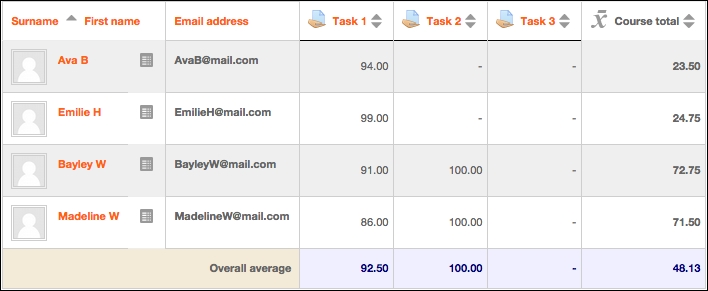
The course totals have changed again, so let's see how this is calculated. In this method of calculating a mean grade, each normalized grade is multiplied by the weight applied to the assessed item. The normalized grades are added together and then divided by the total weights applied to the course. The following table shows you the calculations for this aggregation method for the grades of Bayley W:
|
Task 1 |
Task 2 |
Task 3 |
Total |
Mean aggregation |
Final grade shown in the Gradebook | |
|---|---|---|---|---|---|---|
|
Maximum grade possible |
100 |
100 |
50 | |||
|
Grade awarded |
91.00 |
100.00 |
0 |
191 |
63.67 | |
|
Weighting |
1 |
2 |
1 |
Total: 4 | ||
|
Normalized grade |
0.91 (91/100*1) |
2 (100/100*2) |
0 (0/50*1) |
2.91 (0.91+2+0) |
0.7275 (1.91/4) |
72.75 (.7275*100) |
Note that Task 2 is multiplied by two as this is the weighting we applied for this assessed activity. The mean aggregation is calculated by dividing the total weighted normalized score by four, as this is the total number of weights applied to the course (that is, a weighting of one for Task 1, a weighting of two for Task 2, and a weighting of one for Task 3).
We have seen three ways of how to calculate a mean grade within a course and customize the Gradebook by choosing to include all assessed activities within the Gradebook rather than just the graded activities. Another popular aggregation method is the sum of grades, which acts differently to the normalized methods already discussed. Let's have a go with this aggregation method. We will also look at some other customizations available in order to change how the grade is displayed within the Gradebook.
